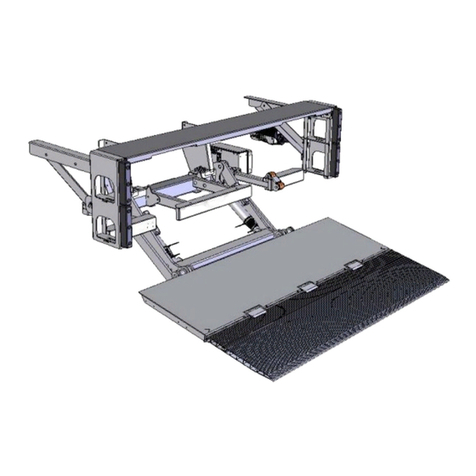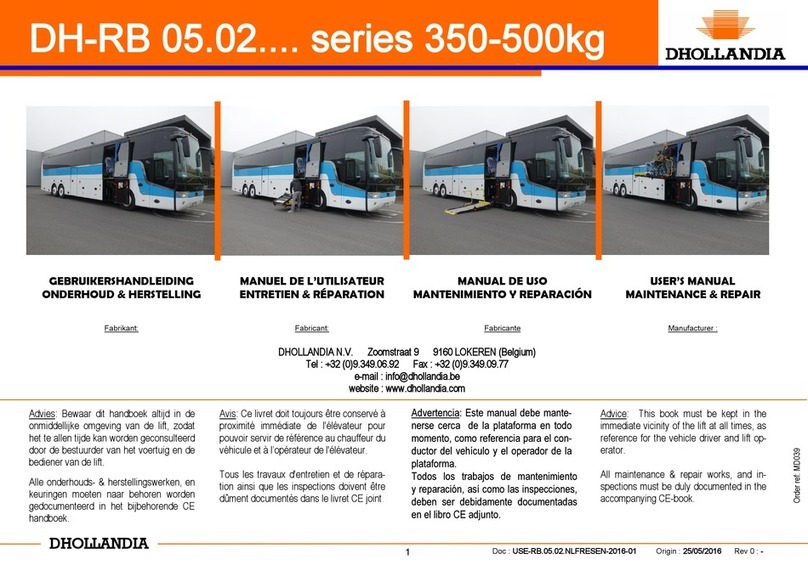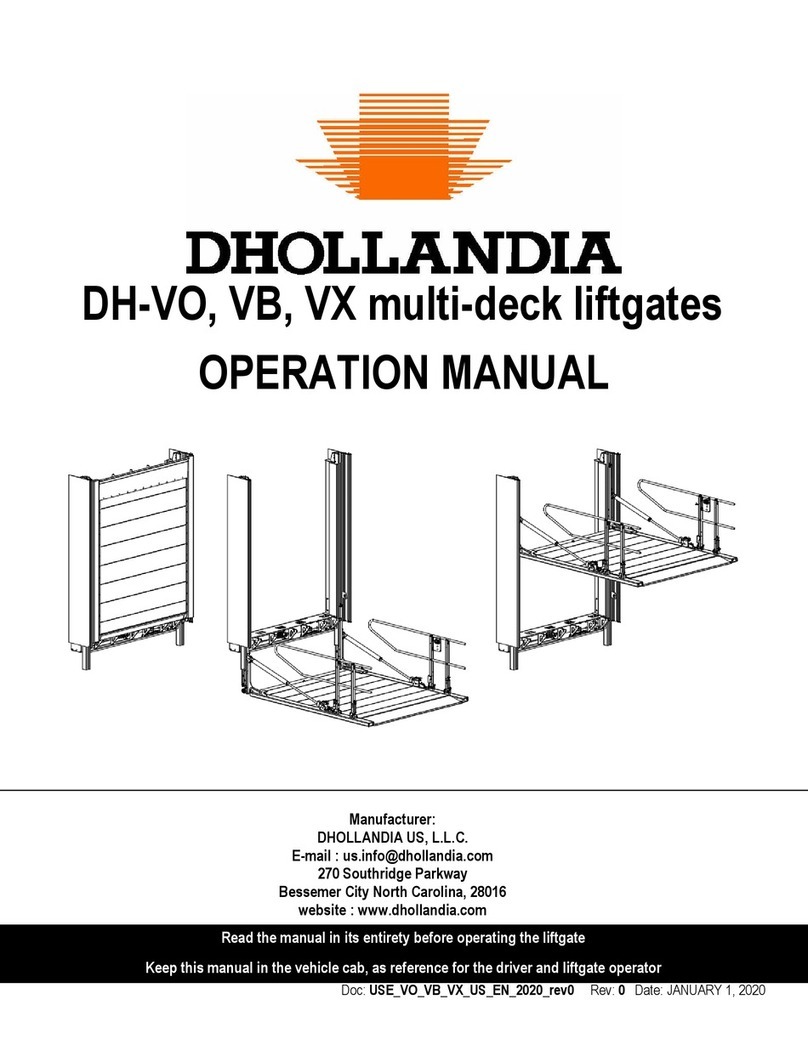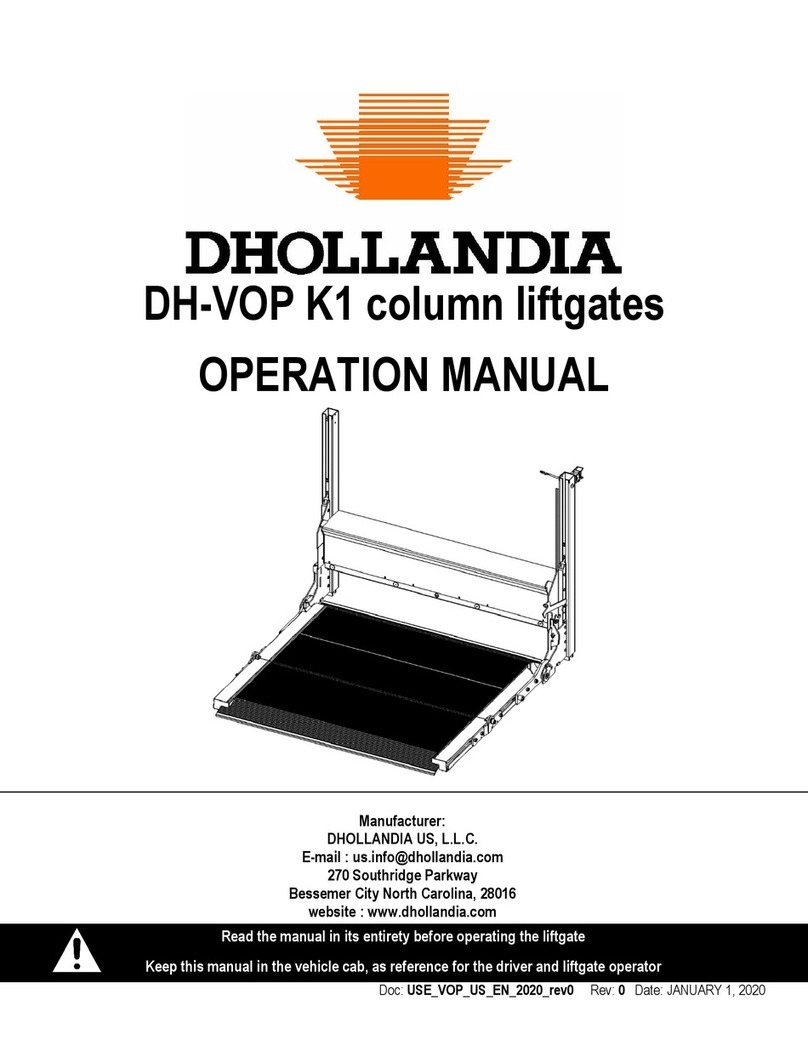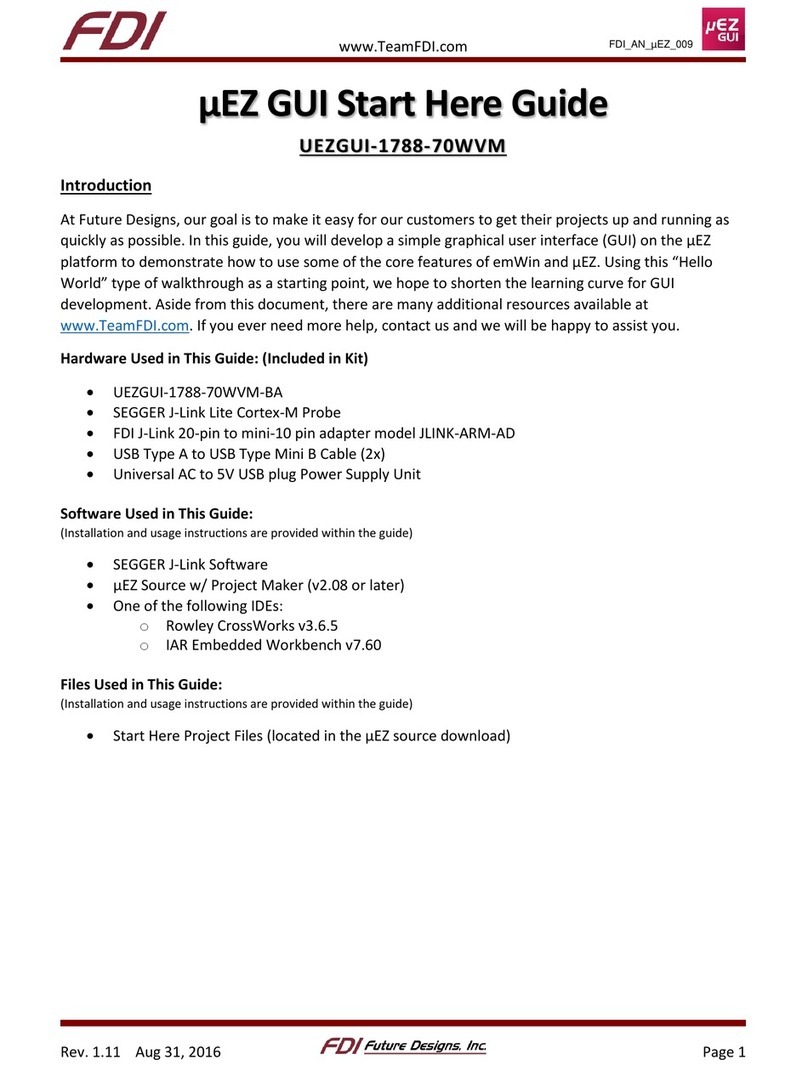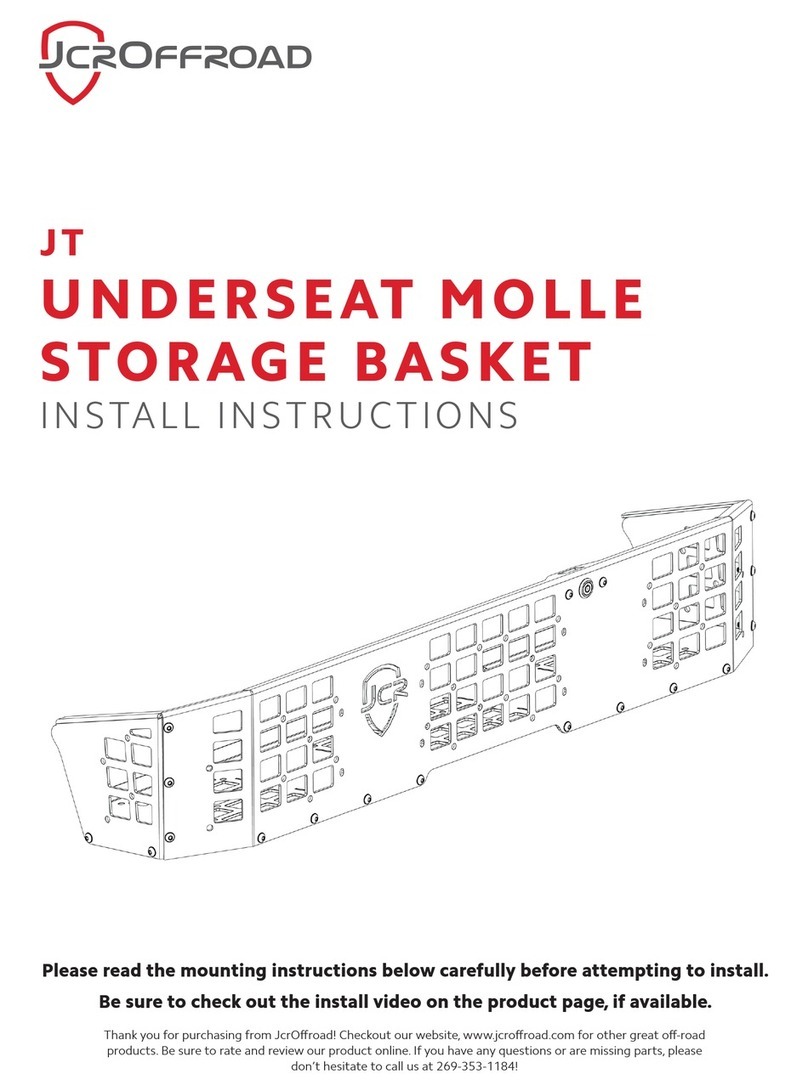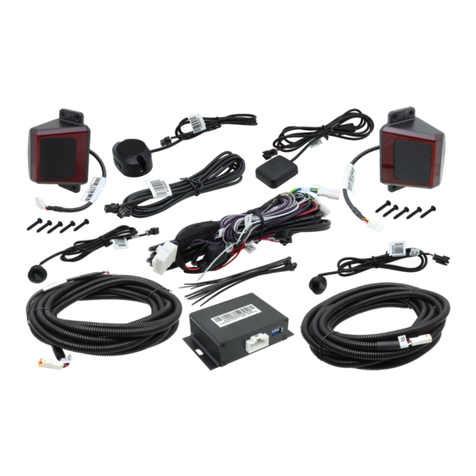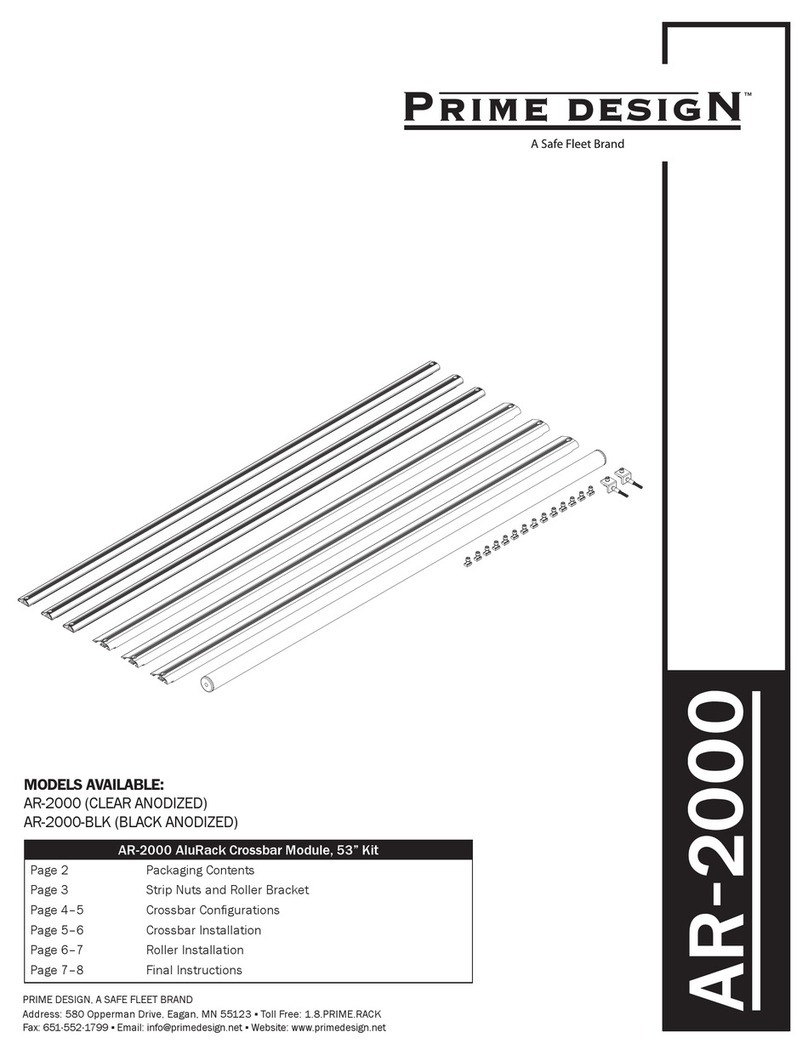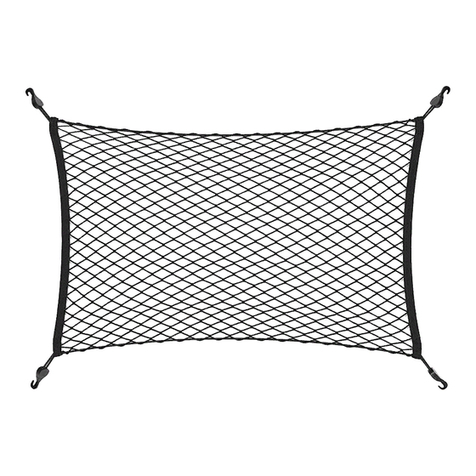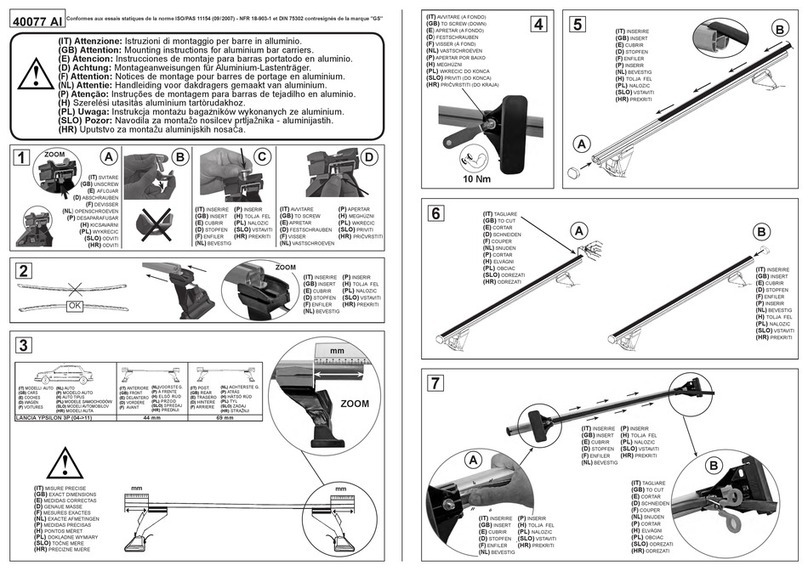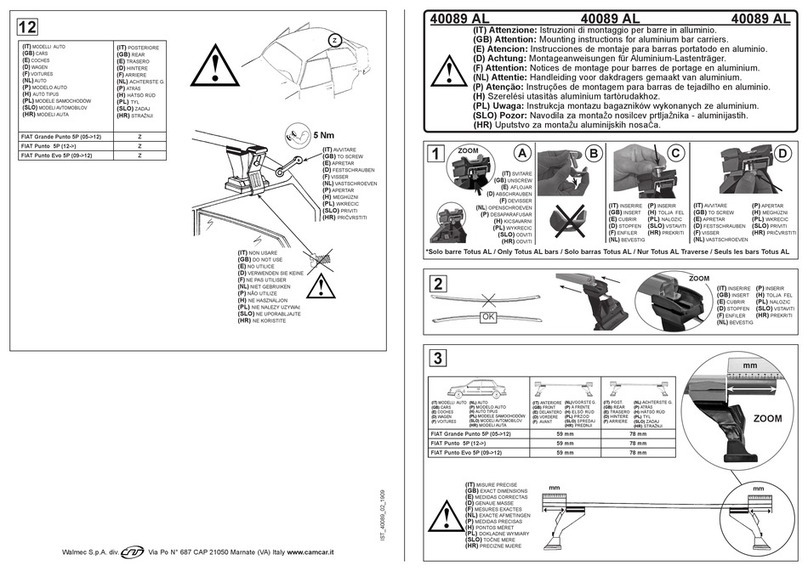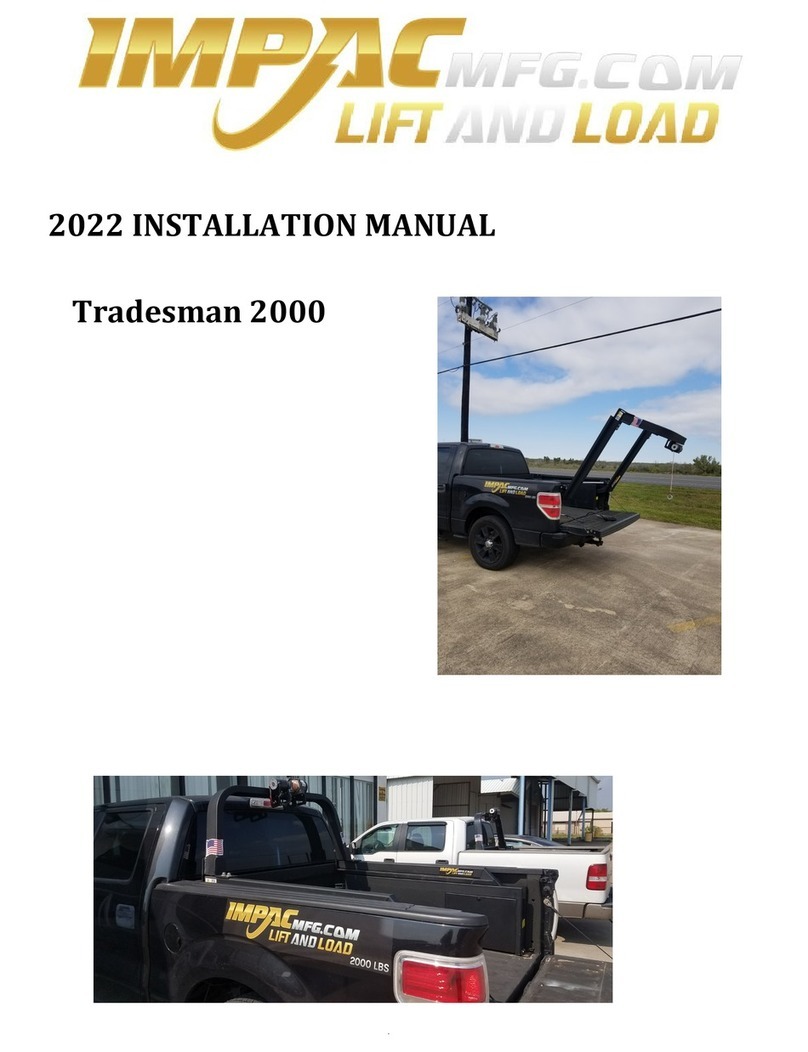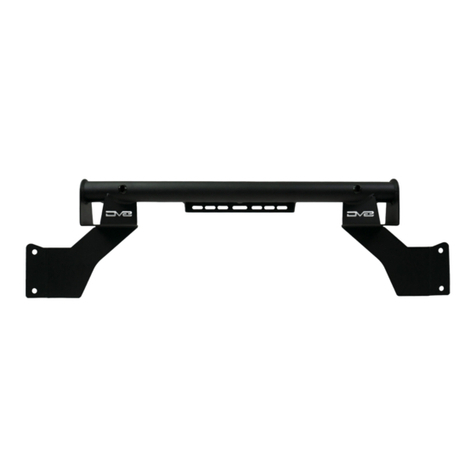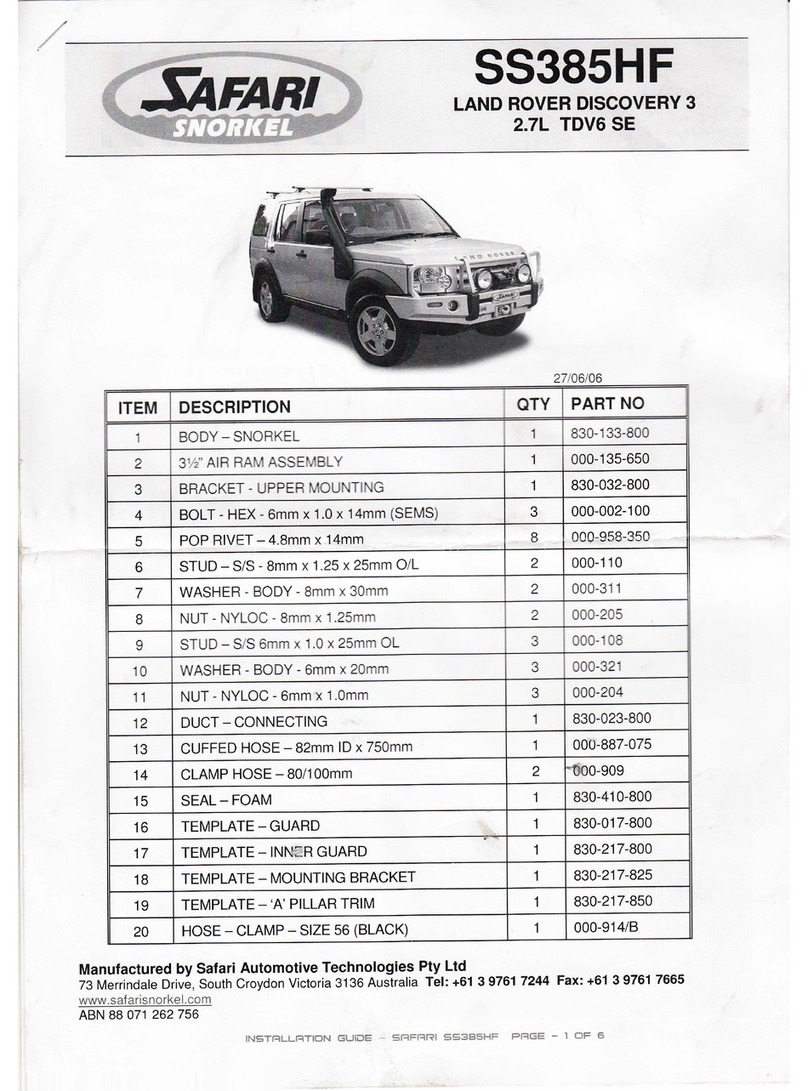Dhollandia DH-CH001 User manual

Order ref: MD036.EN Doc: USE_DH-CH001_CE_EN_2020 Rev: 0 Date: NOV 20, 2020
Manufacturer:
DHOLLANDIA N.V. Zoomstraat 9 9160 LOKEREN (Belgium)
Tel : +32 (0)9 349 06 92 Fax : +32 (0)9 349 09 77
e-mail : info@dhollandia.be
website : www.dhollandia.com
DH-CH001 / C001
OPERATION MANUAL
Read the manual in its entirety before operating the lift
Keep this manual in the vehicle cab, as reference for the driver and lift operator
edition

1
DHOLLANDIA
TABLE OF CONTENTS
1Understanding safety and warning signs ...................................................................................................................................2
2Contact information and disclaimers..........................................................................................................................................3
3General introduction...................................................................................................................................................................4
4Intended use ..............................................................................................................................................................................4
5Identification...............................................................................................................................................................................5
6Description and terminology ......................................................................................................................................................6
6.1 General .............................................................................................................................................................................6
6.2 Safety devices...................................................................................................................................................................9
7Safety instructions for using the lift ..........................................................................................................................................12
7.1 DO NOT use the lift without adequate safety and operator training................................................................................12
7.2 General safety instructions..............................................................................................................................................12
7.3Danger zones, risk of crush and shear injury..................................................................................................................16
7.4 Additional instructions for the wheelchair occupants and standees ................................................................................19
7.5 Load diagram ..................................................................................................................................................................21
7.6 Recommended daily pre-trip inspection..........................................................................................................................22
7.7 Importance of preventative maintenance ........................................................................................................................23
8Operating instructions –principles and procedures .................................................................................................................24
8.1 Control units....................................................................................................................................................................24
8.1.1 2-button wander lead with spiral cable (ref. OAE001) on DH-C001* ..........................................................................24
8.1.2 3-button wander lead with spiral cable (ref. OWE002) on DH-CH001*.......................................................................24
8.2 Switching the main power on/off .....................................................................................................................................25
8.3 Operation instructions for DH-CH001* ............................................................................................................................26
9Emergency operation of the DH-CH001*.................................................................................................................................30
10 Decals......................................................................................................................................................................................35
10.1 Introduction .....................................................................................................................................................................35
10.2 Regular decals on the lift.................................................................................................................................................35
10.3 Decals on inside of bus near the lift ................................................................................................................................36
11 Meaning of safety and warning signs.......................................................................................................................................38
12 End note...................................................................................................................................................................................40

2
DHOLLANDIA
1UNDERSTANDING SAFETYAND WARNING SIGNS
Many safety signs and symbols used in this manual are based on international standards, others refer to specific situations or
actions.
Consult section 11 on page 38 for an overview of signs and symbols used in DHOLLANDIA manuals and their meaning.
Please take special notice of the following signs used in the manual. They indicate the likelihood and severity of a potential
injury if a person fails to follow the instructions presented on the safety sign.
WARNING
Failure to understand and to follow the instructions in this manual can put the operator and any bystanders at great risk of
serious bodily injury and death.
Prior to operating the lift, make sure you understand the safety and warning signs used, and read them in conjunction with the
instructions in this manual.
If in doubt, DO NOT operate the lift. Contact your national DHOLLANDIA distributor. See page 3 for contact info.
NOTICE
DANGER: indicates an imminently hazardous situation which, if not avoided, will result in death
or serious injury. [white letters on red background]
WARNING: indicates a potentially hazardous situation which, if not avoided, could result in death
or serious injury. [black letters on orange background]
CAUTION: indicates a potentially hazardous situation which, if not avoided, could result in minor
or moderate injury. [black letters on yellow background]
NOTICE: is used to address practices not related to physical injury. [white letters on blue
background]
SAFETY INSTRUCTIONS: indicate general instructions relative to safe work practices,
reminders of proper safety procedures, or the location of safety equipment. [white letters on
green background]
SAFETY
INSTRUCTIONS
SAFETY ALERT SYMBOL: is used to alert the user to potential hazards. All safety messages
that accompany this sign shall be obeyed to avoid possible harm. [free-standing, or on back-
ground colours red, orange, yellow or black]

3
DHOLLANDIA
2CONTACT INFORMATION AND DISCLAIMERS
DHOLLANDIA lifts are regularly being adapted to new vehicle and chassis developments and specialized customer
requirements. Therefore, DHOLLANDIA reserves the right to alter product specifications without prior notice and potentially
modifications or new developments might not have been taken into account at the time of printing.
NOTICE
Please confirm you have reviewed the most up-to-date version of this manual prior to operation of the associated DHOLLANDIA lift.
See below for instructions to download the latest version of the manual.
Contact your national DHOLLANDIA distributor if you have any questions regarding the installation, operation, repair and
maintenance of DHOLLANDIA lifts, to obtain replacement copies of manuals or decals, or to learn about available equipment
options for DHOLLANDIA lifts.
Take notice of following important disclaimers:
DISCLAIMERS
DHOLLANDIA disclaims liability for any personal injury, death or property damage that results from operating a lift that has
been modified from the original design, without explicit written approval from the manufacturer.
DHOLLANDIA disclaims liability for any personal injury, death or property damage that results from the use of aftermarket or
non-OEM replacement parts for service or repair of the lift.
DHOLLANDIA disclaims liability for any personal injury, death or property damage that results from improper use of the lift.
DHOLLANDIA disclaims liability for any personal injury, death or property damage that results from overloading or improperly
loading the platform, disregard of the maximum rated lift capacity and the applicable load charts.
There are no warranties, express or implied, including the warranty of merchantability or a warranty of fitness for a particular
purpose extending beyond that set forth in this manual.
If in doubt where to find your national DHOLLANDIA distributor, visit the official DHOLLANDIA website
www.dhollandia.com → Country selection / language selection → Distributors & service
The latest version of all manuals can also be downloaded from the DHOLLANDIA website
www.dhollandia.com → Country selection / language selection → Downloads → Operation
manuals → … select required manual

4
DHOLLANDIA
3GENERAL INTRODUCTION
The manuals mentioned below apply to various types of lifts DH-CH001*, DH-C001* operating in a similar way. In case of any
doubt, always contact your national DHOLLANDIA distributor. See contact info on page 3.
The DH-CH001* are wheelchair lifts, used to assist wheelchair occupants or persons with an impaired mobility embark and
disembark the vehicle. The DH-C001* are commercial lifts, used to handle cargo.
This OPERATION MANUAL explains how the DHOLLANDIA lift is manufactured, what safety devices are incorporated in its
design and how to use the lift in a correct manner, that preserves the integrity of the machine over the intended lifetime and
helps maximize the safety of the operator and any bystanders.
The MAINTENANCE AND REPAIR MANUAL (separate) explains how to maintain and service the lift in the appropriate manner,
maximizing the safety of the operator and any bystanders and ensuring the reliability of the lift over the intended lifetime.
The CE IDENTIFICATION AND INSPECTION LOGBOOK (separate) contains the serial number identification, the CE
Declaration of Conformity, the Fitting Declaration to be filled out by the installer of the lift, and an overview of the owner’s legal
obligations in terms of periodic testing and certification.
The manuals must be kept with the lift at all times, as a reference book for the operators and technical service.
4INTENDED USE
DHOLLANDIA wheelchair lifts DH-CH001* are designed to be fitted to multi passenger vehicles, busses and coaches, and shall be
used exclusively to assist wheelchair occupants or persons with an impaired mobility embark and disembark the vehicle, within the
limits of the load chart, in compliance with the operator instructions and safety instructions described in this manual.
DHOLLANDIA commercial lifts DH-C001* are designed to be fitted to vans and light-duty commercial vehicles, and shall be used
exclusively to load and unload the goods transported on the vehicle they are fitted to, within the limits of the load chart, in compliance
with the operator instructions and safety instructions described in this manual.
WARNING
Improper use of the lift will put the operator and other parties at great risk of serious bodily injury and death. Therefore, the use
of the lift is restricted to skilled operators only; who have been properly trained, and who know and understand the full contents
of this manual.
Unauthorized modifications to the lift can put the operator and other parties at great risk of serious bodily injury and death.
Therefore, it is strictly forbidden to modify the lift and its safety devices in any way.
The use of aftermarket or non-OEM replacement parts to repair the lift is strictly prohibited and may result in serious bodily
injury or death of the operator or any bystanders.
WARNING
Improper use of the lift will put the operator and bystanders at great risk of serious bodily injury and death. Therefore, it is strictly
forbidden to use the lift in a different way, or for different purposes than described in the operation manual.
The lift must NEVER be used as an elevated work platform, to push loads, to move snow or other debris.
DHOLLANDIA disclaims liability for any personal injury and / or property damage that results from improper use.

5
DHOLLANDIA
5IDENTIFICATION
Every DHOLLANDIA lift is identified by and labelled with a unique 8-digit serial number (with or without a space between the
first and last 4 digits). Use this number for any inquiry on a particular lift, or when ordering replacement parts.
In addition to the lift type and serial number, the various serial number labels provide additional information such as: the
maximum rated lift capacity and load chart, the date of manufacture, etc...
A large label is usually affixed to the
vehicle body near the lift.
Medium sized labels are affixed to the
lift frame, to the platform and to the
power pack.
Small labels are affixed to the
hydraulic cylinders and the electric
motor inside the power pack.

6
DHOLLANDIA
6DESCRIPTION AND TERMINOLOGY
6.1 GENERAL
The DH-CH001* are wheelchair lifts, used to assist wheelchair occupants or persons with an impaired mobility embark and
disembark the vehicle. These wheelchair lifts incorporate a number of safety devices that are not required on commercial lifts.
The DH-C001* are commercial lifts derived from aforementioned wheelchair lifts. They are used to handle cargo.
In this manual the following terms will be used:
1. Lift = refers to both wheelchair and commercial lifts
2. Wheelchair lift = refers to wheelchair applications only abbreviation [W]
3. Commercial lift = refers to commercial cargo handling applications only abbreviation [C]
In one and the same sentence, the abbreviations [W] and [C] will be used to include one type of lift and exclude the other.
DHOLLANDIA lifts are developed and manufactured using state-of-the-art technology, high quality materials and components,
and highly skilled workmanship. They comply with the European CE safety regulations mentioned in the Declaration of
Conformity issued with each lift (unless otherwise agreed for tail lifts exported outside the CE region).
The DH-CH001* and DH-C001* are “cassette lifts” In travel position, the platform and lift frame are safely stored inside a sealed
“cassette”. Upon deployment, the platform and lift frame are slid out of the cassette. Then the flip-over point is unfolded, a bridge
plate and guard rails are deployed to make the lift ready for use.
On DH-CH001* wheelchair lifts, the movement of the platform in and out of the cassette, is operated by a hydromotor and
gearwheel system. On DH-C001* commercial lifts, this movement is done manually.
.
Main details and terminology: see below.
DH-CH001* / C001* ●TERMINOLOGY
See figure below for parts corresponding to numbers in this table
#
Description
1
Cassette: sealed box housing the lift frame and platform when stowed in travel position, and protecting the mechanism
against adverse weather conditions.
The cassette is equipped with slide rails and a retraction system to slide the lift frame and the platform from a travel position
deep inside the cassette to a work position at the outboard edge of the cassette, and vice versa.
2
Mounting brackets: brackets used to mount the cassette to the vehicle.
3
Lift frame: steel assembly incorporating the lift arms and lift cylinders, who together carry the platform.
[W] →The lift frame is moved in and out of the cassette by means of a hydromotor and gearwheel system.
[C] →The lift frame is moved in and out of the cassette manually.
4
Lift arms + lift cylinders: 2 lift arms L+R actuated by the lift cylinders, used to lift / lower the platform and its load (=
functions UP / DOWN).
5
Platform: carries the load during lifting / lowering. The platform consists of a steel frame and aluminium profiles with a
non-slip surface. The platform is foldable into 2 halves and is made up of a platform main section and a flip-over point. It
is further equipped with a bridge plate, guard rails and a roll stop flap.
5a
Platform main section: inboard main section of the foldable platform, attached to the lift arms.
5b
Flip-over point: foldable, outboard section of the platform.
6
Bridge plate: plate mounted at the inboard platform edge, used to bridge any gap between the platform and the vehicle
floor when the platform is raised to its maximum height.
7
Guard rails [W]: fall protections mounted at both sides of the platform, protecting the wheelchair occupant and his
attendant from falling off the platform. The guard rails must be deployed manually and secured in the upright position prior
to using the lift, they must be stowed manually before retracting the lift back into its travel position.
8
Roll stop: roll stop mounted at the outboard platform edge. The roll stop is tilted up automatically when the platform leaves
the ground, it is tilted down automatically when the platform touches the ground.

7
DHOLLANDIA
The roll stop prevents the wheelchair from slowly and unexpectedly rolling off the platform during lifting and lowering. It is
not designed to stop fast and powered movements. See also 7.4 on page 19.
9
Cover: aluminium cover closing the outboard aperture of the cassette. Together with the cassette lock, the cover holds
the lift frame and platform inside the cassette while the lift is not being used.
10
Cassette lock: mechanical lock at the side of the cover. Together with the cover, the cassette lock holds the lift frame and
platform inside the cassette while the lift is not being used.
The cassette lock must be released by foot or hand to deploy the platform. The cover should close automatically and the
cassette lock should engage automatically when stowing the platform.
11
Step: step mounted on top of the cassette (depending on the mounting position of the cassette under the vehicle). The
step facilitates the access when stepping in and out of the vehicle (when the lift is not in use).
12
Wander lead with spiral cable: control box to execute all functions
[W] →3-button wander lead for the 4 functions DEPLOY –UP –DOWN - STOW.
[C] →2-button wander lead for the 2 functions UP –DOWN.
13
Hydraulic power pack: contains the electric motor driving the hydraulic pump, the oil tank, and the control valves. It is
integrated in the lift frame, and stored inside the cassette while the lift is not being used.
DH-CH001* ● CASSETTE LIFT ● TERMINOLOGY
INBOARD
platform edge
OUTBOARD
platform edge

8
DHOLLANDIA
POWER PACK ●TERMINOLOGY
See figure below for parts corresponding to numbers in this table
#
Description
1
Hydraulic power pack: contains the electric motor driving the hydraulic pump, the oil tank, and the control valves. It is
integrated in the lift frame and stored inside the cassette while the lift is not being used.
2
Cover: aluminium cover closing the outboard aperture of the cassette. Together with the cassette lock, the cover holds
the lift frame and platform inside the cassette while the lift is not being used.
3
Cassette lock: mechanical lock at the side of the cover. Together with the cover, the cassette lock holds the lift frame and
platform inside the cassette while the lift is not being used.
The cassette lock must be released by foot or hand to deploy the platform. The cover should close automatically and the
cassette lock should engage automatically when stowing the platform.
4
Hydraulic hand pump: manual back-up pump to lift the platform in case of an electrical power failure (= function UP). The
lever [# 4a] for the hand pump is stored at the front of the power pack.
5
Emergency valve: electrovalve with lever for manual override. The valve must be opened manually to lift (= function UP)
and lower the platform (= function DOWN) in emergency operation.
6
Emergency Descent button: electrovalve with push button for manual override. The valve must be opened manually to
lower the platform (= function DOWN) in emergency operation.
7
Slider drive system [W]: hydromotor and gearwheel system driving the platform and lift frame in / out.
[W] →The lift frame is moved in and out of the cassette by means of a hydromotor and gearwheel system.
[C] →The lift frame is moved in and out of the cassette manually.
7
2
3
4a
4
5
6
1

9
DHOLLANDIA
6.2 SAFETY DEVICES
DHOLLANDIA lifts are equipped with a multiple safety devices to enable its intended use with a maximum degree of safety for
the operator, the wheelchair occupant on the platform and any incidental bystanders. The following safety devices are
incorporated on the DH-CH001* / C001* series:
N°
Description
Image
1
Non-slip surface: the surface of the aluminium platform and bridge plate
incorporates a non-slip profiling to prevent the operator and platform occupants
from slipping and falling.
2
Roll stop: roll stop mounted at the outboard platform edge. The roll stop is tilted
up automatically when the platform leaves the ground, it is tilted down
automatically when the platform touches the ground.
The roll stop prevents the wheelchair from slowly and unexpectedly rolling off
the platform during lifting and lowering. It is not designed to stop fast and
powered movements. See also 7.4 on page 19.
3
Guard rail(s) [W]: fall protections mounted at both sides of the DH-CH001*
platform, protecting the wheelchair occupant and his attendant from falling off
the platform. The guard rails must be deployed manually and secured in the
upright position prior to using the lift, they must be stowed manually before
retracting the lift back into its travel position.
4
Bridge plate: plate mounted at the inboard platform edge, used to bridge any
gap between the platform and the vehicle floor when the platform is raised to its
maximum height.
The bridge plate tilts down automatically as the platform approaches the vehicle
floor. It tilts up automatically as the platform lowers to the ground.
It also forms a toe-guard for the operator and the wheelchair occupant while
travelling up / down on the platform.

10
DHOLLANDIA
5
Cover and cassette lock: The cover and cassette lock secure the platform and
the lift frame in their travel position.
The cassette lock must be released by foot or hand to deploy the platform. The
cover should close automatically and the cassette lock should engage
automatically when stowing the platform.
6
End stop for STOW:switch mounted on the lift arm, to automatically stop the
platform at the correct height to slide in and stow the platform in its travel
position. This system prevents trial and error, and mechanical damage of the lift.
7
Cabin switch provided by the truck manufacturer or DHOLLANDIA [option
OAE503.1]. This switch enables the operator to switch the control power to the
lift on / off from a position in the vehicle cabin.
8
Main battery fuse: a main fuse 100 –150A is supplied by the vehicle
manufacturer or by DHOLLANDIA. It protects the main battery cable from the
batteries to the power pack of the lift against short circuits and amperage peaks.
9
15A fuse: lighter fuses are used to protect the control unit, associated wires and
the printed circuit against short circuits and amperage peaks.

11
DHOLLANDIA
10
Emergency Descent button: electrovalve with push button for manual override.
The valve must be opened manually to lower the platform (= function DOWN) in
case of an electrical power failure.
11
Hydraulic hand pump: manual back-up pump to lift the platform in case of an
electrical power failure (= UP).
12
Pressure relief valve: safety device integrated in the power pack, enabling the manufacturer and the installer of the lift to limit
the real lift capacity to the maximum rated capacity of the lift sold, and protect it against overload while lifting (= UP).
13
Pressure compensated flow valves: flow valves are integrated in the hydraulic circuits to ensure the platform lowers at a safe
speed, both empty and when fully loaded.
14
Decals: the lifts are supplied with a number of operation decals, load diagrams and safety decals. Some of these decals are
premounted by DHOLLANDIA on the lift. Some of these decals are supplied loose and shall be affixed by the installer near to
the lift at a location clearly visible to the operator.
The decals must be kept clean and legible at all times, and replaced whenever required.

12
DHOLLANDIA
7SAFETY INSTRUCTIONS FOR USING THE LIFT
7.1 DO NOT USE THE LIFT WITHOUT ADEQUATE SAFETY AND OPERATOR TRAINING
DHOLLANDIA lifts shall be exclusively use in accordance with the INTENDED USE as described in section 4 on page 4, within
the limits of the applicable load chart, in compliance with the operator instructions and safety instructions in this manual.
The operator should follow all other policies and procedures applicable to the job situation including health and safety
regulations, road and traffic regulations, as well as company procedures. The operator should not use the lift if he/she cannot
use it in accordance with all applicable regulations and instructions.
The operator must be at least 18 years of age.
7.2 GENERAL SAFETY INSTRUCTIONS
WARNING
To avoid serious bodily injury or death, the operator must use appropriate work clothes. NEVER wear loose-fitting clothes that
may be trapped in the moving parts of the wheelchair lift. ALWAYS wear professional safety-toe shoes, protective gloves, and
eye protection. Use of a hardhat is recommended.
Must
Recommended
Slipping (and falling) can result in serious bodily injury and death. To prevent injury by slipping:
oALWAYS wear professional safety-toe shoes with a good non-slip sole.
oDO NOT use the lift if it is covered with snow, mud, dirt, debris, liquids or other substances.
oDO NOT run on the platform.
Tripping (and falling) can result in serious bodily injury and death. To prevent injury by tripping:
oDO NOT use lift platform as a step. NEVER leave the lift unattended in partially deployed position.
oPay attention to protruding items on the platform surface at all times (ex. platform lights, roll stops and their
levers, foreign objects, etc…).
oDO NOT run on the platform.
Falling from the platform can result in serious bodily injury and death. To prevent injury by falling:
oMake sure your footing is solid and you maintain 3 points of contact (2 feet on the platform, 1 hand on a
guard rail).
oUse guard rails where available. See 7.4 from page 19 onwards.
oNEVER move the vehicle while a person is standing on the platform or inside the vehicle body.
oNEVER use the platform as an elevated working platform.
WARNING
Improper use of the lift will put the operator and other parties at great risk of serious bodily injury and death.
To reduce the risk of serious bodily injury to the operator and any bystanders, the use of the lift is restricted to skilled operators,
who have been properly trained, and who know and understand the full contents of this manual.
To reduce the risk of serious bodily injury or death, THE OPERATOR MUST COMPLY WITH ALL SAFETY INSTRUCTIONS
AND WARNING LABELS IN THIS SECTION AND THE ENTIRE MANUAL before and while operating the lift.

13
DHOLLANDIA
WARNING
Prior to operating the lift, the vehicle must be safely parked on level and solid ground, have the parking brake applied, and the
engine switched off. Open any doors located in front of the lift and secure any moving parts of the vehicle body. Failure to abide
by these instructions can result in serious bodily injury or death to the operator or bystanders.
Prior to deploying the platform, check if the lift can be used safely. Take precautions to ensure your own safety, and the safety
of bystanders or other parties in traffic. Clear the working area of any objects that could potentially impede movement of the lift.
Failure to abide by these instructions can result in serious bodily injury or death to the operator or bystanders.
To reduce the risk of serious bodily injury or death which may result from other vehicles when parked, ALWAYS make sure a
safety distance of 16 ft or 5 m is kept between the back of the vehicle and the following vehicle.
Ensure that the vehicle cannot tip-over when putting weight on the platform. If the vehicle is equipped with mechanical or
hydraulic stabilizing legs, deploy these before opening the platform. Ensure that the stabilizing legs are positioned on solid even
ground. In case of soft terrain (sand, gravel…), solid support blocks must be used under the stabilizing legs. Failure to abide by
these instructions can result in serious bodily injury or death to the operator or bystanders.
To reduce the risk of serious bodily injury or death, ALWAYS
make sure the platform is clearly visible to other persons from
all approach directions. The lifts are equipped with flashing
platform lights. Nevertheless, DHOLLANDIA recommends
the use of 4 warning cones, placed around the work area of
the platform.
To reduce the risk of serious bodily injury or death, make sure
the working zone is sufficiently lighted.

14
DHOLLANDIA
WARNING
Inspect the lift prior to each use. If any unsafe condition exists or unusual noises or movements are noticed, DO NOT use the
lift and contact an authorized DHOLLANDIA service agent for repair. Please see ‘pre-trip inspection’ procedures under 7.6 from
page 22 onwards.
Read and comply with all warning decals, pictograms and instructions affixed to the lift. Failure to abide by warnings and
instructions may result in serious bodily injury or death.
The lift must not be used if the operator is intoxicated, impaired or distracted in any way. NEVER use a phone or mobile device
when operating the lift.
The lift shall be used by means of original control units only. Operating the lift with unauthorized control units will increase risk
of serious bodily injury or death to the operator or any bystanders.
Limit the operation of the lift to one single operator. Operation of the lift by more than one operator at a time may cause confusion
and increase the risk of serious bodily injury or death.
To prevent people from being hit by the platform, by objects falling off the platform; being caught in pinch points or being pinched
by the moving parts of the lift:
Keep visual control over the entire working area of the lift and its platform at all times, including the
area DIRECTLY BEHIND and UNDER the platform.
Upon deployment, DO NOT allow any other person to stand in the proximity of the lift and its platform.
ENSURE AT ALL TIMES THAT NOBODY STANDS UNDER OR WITHIN REACH OF THE MOVING
PLATFORM.
Upon lifting and lowering: DO NOT allow any other person, except the person to be lifted or lowered,
to be in the proximity of the lift and its platform.
Careful supervision is necessary if used on behalf of, or near children.
NEVER leave the lift unattended in open position. Before leaving the vehicle unattended, close the doors of the vehicle, stow
the platform in its travel position and switch off the electrical power to the lift. Leaving the lift in open position unattended can
result in serious bodily injury or death to unaware bystanders. See 8 from page 24 onwards for instructions on properly stowing
platform into its travel position.
NEVER move the vehicle with the lift in the open position. ALWAYS stow the lift in its travel position, close and secure the
doors of the vehicle and switch off the electrical power to the lift before moving the vehicle. Failure to properly stow the lift in its
travel position prior to moving the vehicle may result in serious bodily injury or death.

15
DHOLLANDIA
NOTICE
The safety instructions in this manual are drawn up with an average, common use of the lift in mind.
For specific applications or work conditions, other instructions might be appropriate to reach a higher level of safety. If contra-
indications exist, a formal risk analysis must be performed by the client’s health and safety management and safe work
procedures for the drivers and operators must be issued.
WARNING
Use of the lift near vehicular traffic may result in serious bodily injury or death from being struck by another vehicle. When
operating the lift on or near a street or parking lot, be sure to stay clear of vehicular traffic. ALWAYS be sure to clearly identify
to other drivers that the lift is in use. DHOLLANDIA recommends use of warning cones to clearly identify to drivers that the lift
is being operated. When the lift is operated near vehicular traffic, wear working clothes in high-visibility colours and a retro-
reflective safety vest.
DO NOT raise the lift with the rear doors partially open. Doing so may damage the doors or the lift platform and may also result
in serious bodily injury or death to the operator or any bystanders.
Above all, USE GOOD COMMON SENSE when operating the lift. DO NOT operate the lift until the contents of this manual
have been read and fully understood. Improper use of the lift increases the risk of serious bodily injury or death to the operator
and any bystanders.

16
DHOLLANDIA
7.3 DANGER ZONES, RISK OF CRUSH AND SHEAR INJURY
There are several main danger zones on and around the platform, that can be hazardous to the operator and any other persons
nearby.
ALWAYS stay clear of the area behind the
platform and the range of motion of the
platform.
ALWAYS beware of the crushing zone between
the lowering platform and the ground.
WARNING
Impact by the platform or the moving parts
of the lift will result in serious bodily injury
or death. To prevent people from being hit
by the platform, by objects falling off the
platform or being caught in pinch points or
being pinched by the moving parts of the
lift:
Keep visual control over the entire
working area of the lift at all times,
including the area directly behind and
under the platform;
DO NOT allow any person to stand
near the lift and its platform. Ensure at
all times that nobody stands under, or
within reach of the moving platform
and its load.
WARNING
Lowering an empty or fully loaded platform
on one’s feet may result in serious bodily
injury. To prevent people from having their
feet crushed or sheared by the lowering
platform:
Keep visual control over the entire
working area of the lift at all times,
including the area directly behind and
under the platform;
When operating the lift from a position
on the ground, ALWAYS stand at the
side of vehicle body, at a safe
distance of minimum 50 cm away
from the moving platform.
Correct operator position
Danger zone

17
DHOLLANDIA
ALWAYS beware of the crushing zone between
rising platform and the lift arms, and between
the moving parts of the lift generally.
When standing inside the vehicle, ALWAYS
beware of the crushing zone between the
bridge plate and the vehicle floor.
WARNING
The operator or other persons approaching too close to these danger zones risk serious bodily injury or death
by pinching, crushing or shearing of limbs, upper body or head. To prevent these hazards:
ALWAYS stand clear of the range of motion of the platform and moving parts of the lift.
Keep hands, feet and upper body clear of pinch points and moving parts of the lift.
When standing on the platform, ALWAYS hold onto the guard rails.
When operating the lift from a different position, ALWAYS stand on the ground at a safe distance from
the platform and the moving parts of the lift.
DO NOT allow any other person to stand near the lift and its platform.
WARNING
The space between the various parts
of the lift arms and lift cylinders
diminishes as the platform rises. Parts
of the body protruding into that area
can be crushed or sheared while lifting,
or stowing the platform. This will result
in serious bodily injury.
Therefore, ALWAYS keep arms, feet
and clothing clear of pinch points and
moving parts of the lift.
NEVER reach over or through any of
the moving parts of the lift.
ALWAYS keep visual control over the
entire working area of the lift.
WARNING
Impact by the platform or moving parts of
the lift can result in bodily injury.
Therefore, also when standing
inside the vehicle, ALWAYS stay
clear of the moving platform.
ALWAYS stand at a safe distance
from the bridge plate as it
approaches the vehicle floor.

18
DHOLLANDIA
NOTICE
NEVER allow anybody to stand on or hinder the bridge
plate at the inboard platform edge when the platform is set
in motion or is in motion.
NEVER allow anybody to stand on or hinder the roll stop at
the outboard platform edge when the platform is set in
motion or is in motion.
WARNING
The operator and the wheelchair occupant or platform occupant SHALL NOT attempt to leave the platform before it has reached
its final position for embarkation or disembarkation, either at the ground or at the vehicle floor.
Any persons assigned to assisting the wheelchair or platform occupant with embarkation or disembarkation, MUST stay out of
reach of the platform until it has reached its final position and has come to a complete stop, either at the ground or at the vehicle
floor.

19
DHOLLANDIA
7.4 ADDITIONAL INSTRUCTIONS FOR THE WHEELCHAIR OCCUPANTS AND STANDEES
WARNING
The roll stop prevents the wheelchair from slowly and unexpectedly rolling off the
platform during lifting and lowering. It is NOT designed to stop fast and powered
movements.
When the wheelchair rolls and falls off the platform, this can cause serious bodily
injury to the wheelchair occupants or any persons standing near the platform.
To maximise the effectiveness of the roll stop, ALWAYS direct the small front
wheels of the wheelchair towards to the roll stop. The roll stop is NOT designed to
bring the big rear wheels of a wheelchair to a positive stop in case of abrupt or
fast movement.
ALWAYS board the platform slowly and cautiously.
Do NOT ride against the roll stop as a means of braking.
ALWAYS engage the parking brakes of the wheelchair prior to moving the
platform.
For electric wheelchairs, ALWAYS put the controls in neutral position and switch
the power off. If possible, the controls should be switched off and set to manual
mode before embarking the platform, and the wheelchair be pushed manually onto
the platform to reduce and control the speed.
Make sure the wheelchair, wheelchair occupant and the standee don’t interfere with the roll stop at the outboard platform edge
and the automatic bridge plate at the inboard platform edge.
Make sure the wheelchair occupant and standee are positioned as close as possible to the vehicle without interfering with the
automatic bridge plate; and centrally between the 2 lift arms
When exiting the vehicle, never back onto the platform. Always face outward, ensure the platform is safely in place at the loading
floor of the vehicle, the guard rails are secured in the upright position and the roll stop is raised and secured in vertical position.
Use extreme care in wet or slippery conditions. Wheelchair brakes are less effective if the platform and / or wheels of the
wheelchair are wet or dirty.
WARNING
A fall of the platform may cause serious bodily injury or death to the platform occupants.
Standees on the platform MUST ALWAYS make sure their footing is solid.
Standees and wheelchair occupants physically capable of doing so, MUST ALWAYS hold onto the guard
rails at the side of the platform.
This manual suits for next models
1
Table of contents
Other Dhollandia Automobile Accessories manuals
Popular Automobile Accessories manuals by other brands
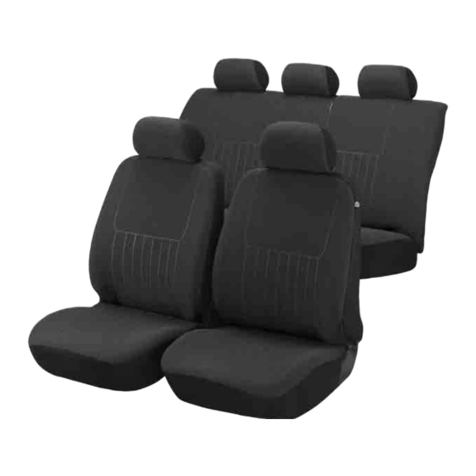
ULTIMATE SPEED
ULTIMATE SPEED 279746 Assembly and Safety Advice

SSV Works
SSV Works DF-F65 manual
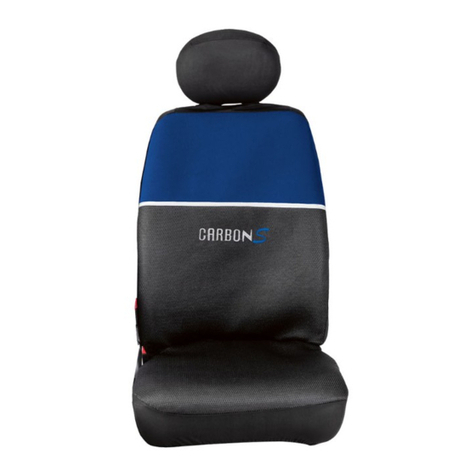
ULTIMATE SPEED
ULTIMATE SPEED CARBON Assembly and Safety Advice
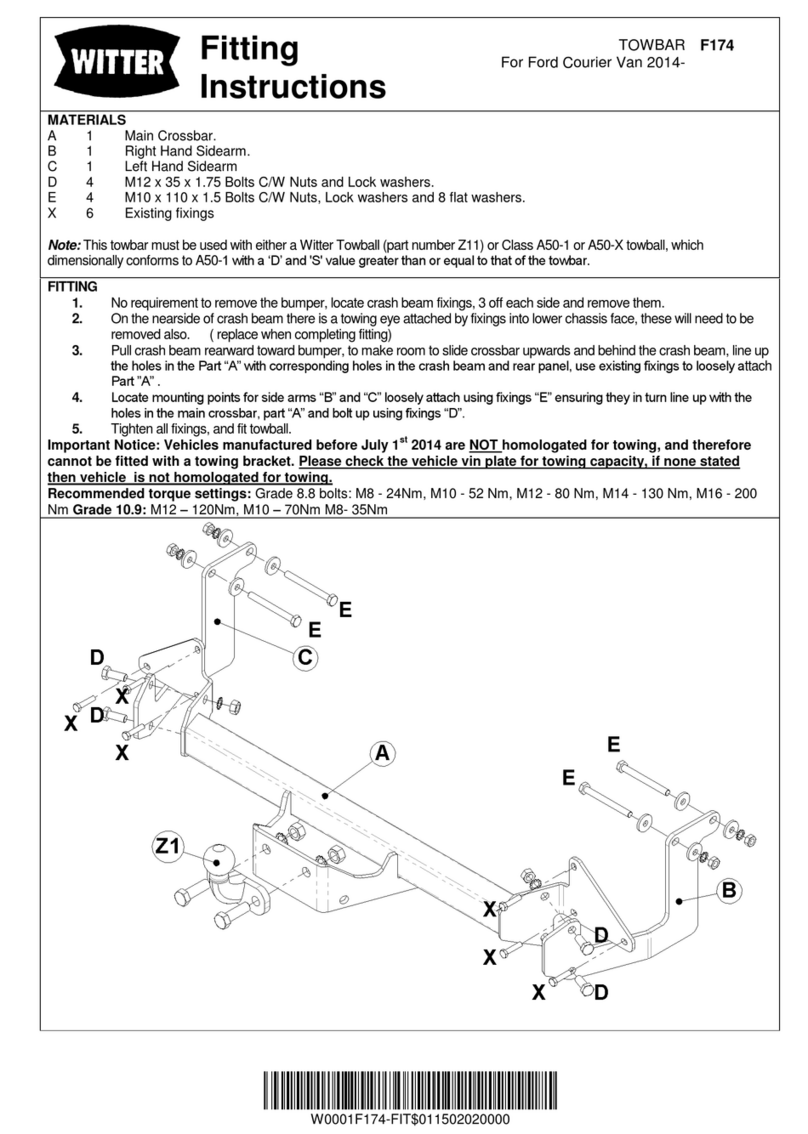
Witter
Witter F174 Fitting instructions
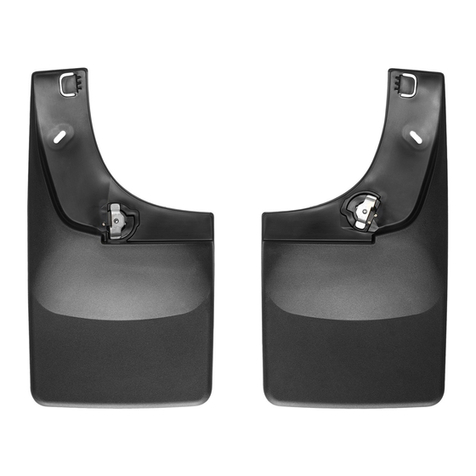
WeatherTech
WeatherTech No-Drill installation instructions
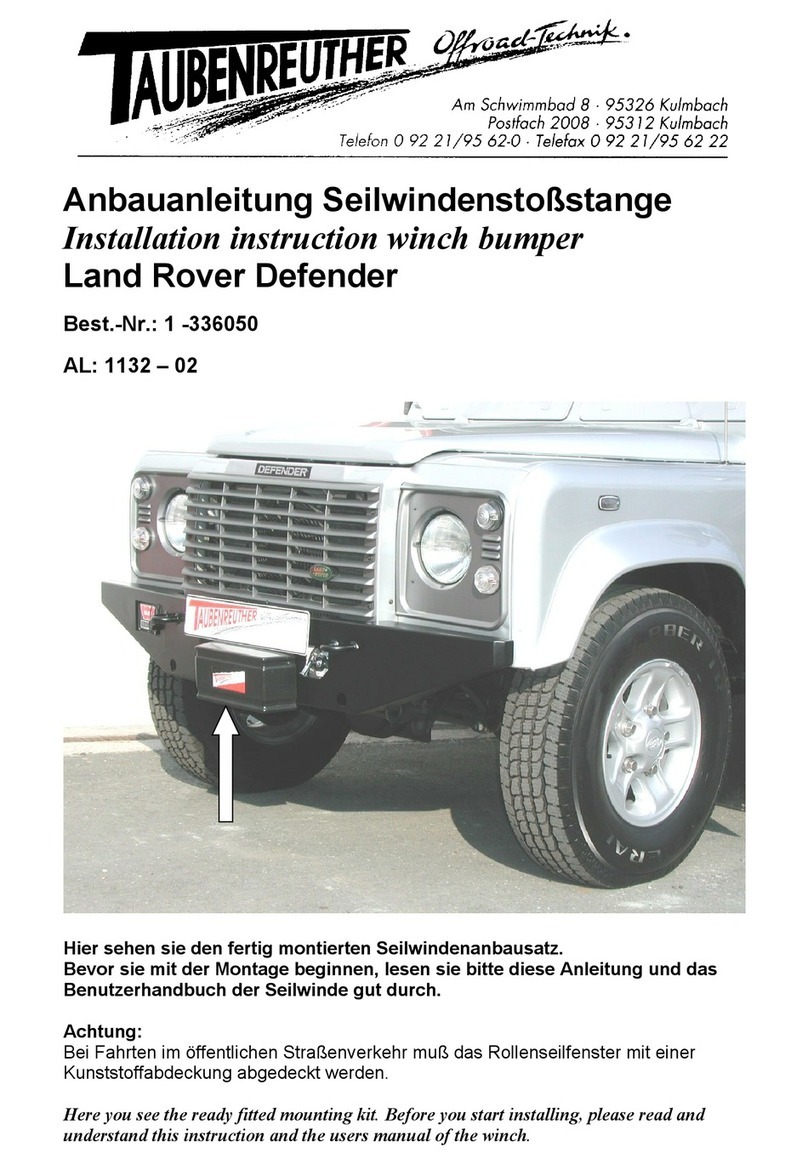
TAUBENREUTHER
TAUBENREUTHER 1-336050 Installation instruction
